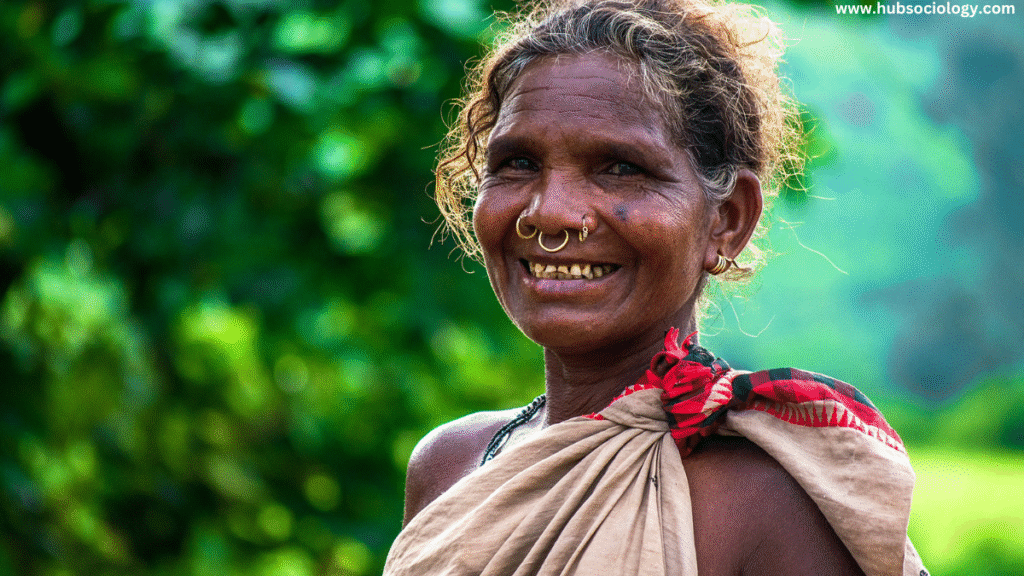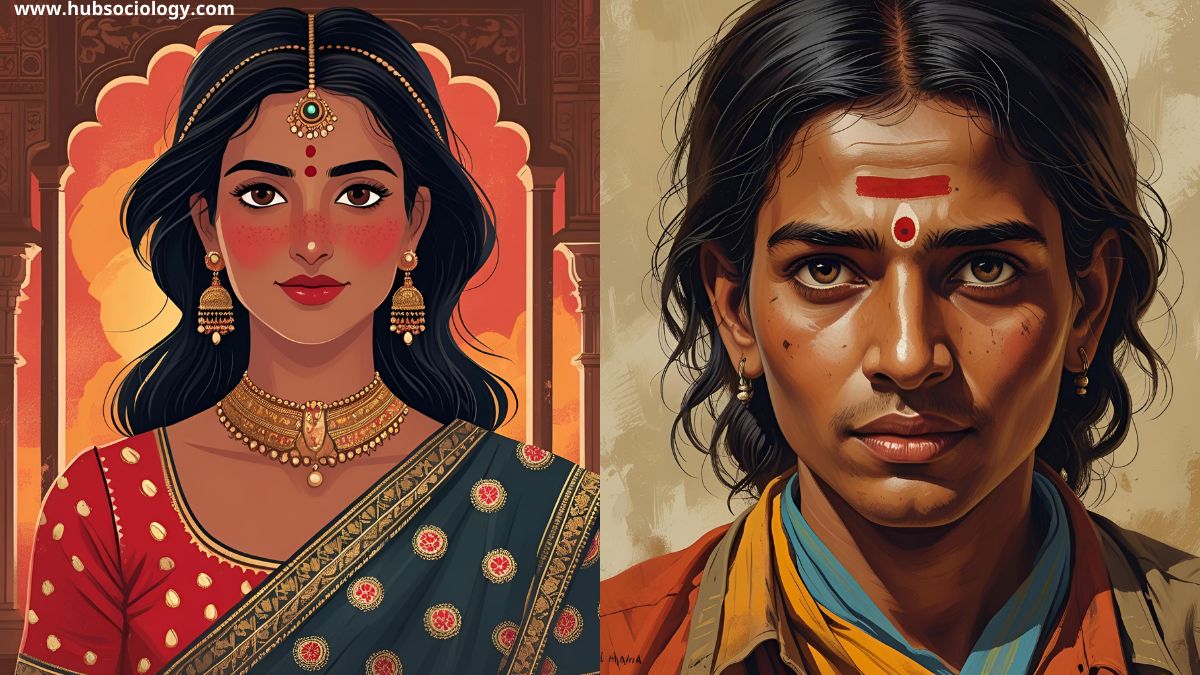Introduction on Varna and Caste System
The Varna and caste system in India is one of the oldest and most complex social stratification systems in the world. Rooted in ancient Hindu scriptures, it has shaped the socio-economic, political, and cultural fabric of Indian society for centuries. From a sociological perspective, the caste system is a hierarchical structure that divides society into rigid groups based on birth, occupation, and ritual purity. While the Varna system was originally a theoretical classification, the caste (Jati) system became its practical manifestation, deeply influencing social interactions, marriage, occupation, and access to resources.
This article examines the origins, structure, and functioning of the Varna and caste system, its impact on Indian society, and the changes it has undergone in modern times. It also discusses the sociological theories that explain caste, its role in perpetuating inequality, and the efforts towards social reform and mobility.

Table of Contents
Origins and Conceptual Framework on Varna and Caste System
1. The Varna System: Theoretical Foundations
The Varna system finds its earliest mention in the Rigveda (1500–1000 BCE), particularly in the Purusha Sukta hymn, which describes society as divided into four Varnas:
- Brahmins (Priests, scholars, teachers)
- Kshatriyas (Warriors, rulers, administrators)
- Vaishyas (Farmers, merchants, artisans)
- Shudras (Servants, laborers)
Outside this four-fold division were the Dalits (formerly “Untouchables”), who performed menial and “polluting” jobs and were excluded from the Varna hierarchy.
The Varna system was initially conceptualized as a functional division of labor, where each group had specific duties (Dharma). However, over time, it became hereditary and rigid, leading to social stratification.
2. Jati: The Caste System in Practice
While Varna was a broad classification, Jati (sub-castes) became the real operational unit of Indian society. There are thousands of Jatis, each associated with specific occupations, customs, and social status. Unlike Varna, Jati was localized, endogamous (marriage within the group), and strictly hierarchical.
Key features of the caste system include:
- Hereditary occupation: A person’s caste determined their traditional job.
- Endogamy: Marriages were restricted within the same caste.
- Social restrictions: Rules governed interactions, dining, and even physical proximity between castes.
- Purity and pollution: Higher castes maintained ritual purity by avoiding contact with lower castes.

Sociological Theories on Caste
Several sociological theories explain the caste system’s persistence and function:
1. Functionalist Perspective (Durkheimian View)
- The caste system maintained social order by assigning fixed roles.
- It ensured division of labor, where each caste contributed to societal needs.
- However, this perspective ignores exploitation and inequality inherent in the system.
2. Marxist Perspective
- Karl Marx viewed caste as a tool for economic exploitation.
- Upper castes (Brahmins, Kshatriyas) controlled land and resources, while lower castes (Shudras, Dalits) provided cheap labor.
- Caste reinforced class divisions, preventing proletarian unity.
3. Weberian Perspective
- Max Weber saw caste as a status group where social honor (prestige) was tied to ritual purity.
- Unlike class (economic position), caste was about social and religious hierarchy.
- Caste restricted social mobility, as status was ascribed (birth-based) rather than achieved.
4. Dr. B.R. Ambedkar’s Critique
- Dr. Ambedkar, a Dalit leader and architect of India’s Constitution, argued that caste was a system of graded inequality.
- He linked caste to Hindu religious sanctions, calling for its annihilation through education and legal reforms.
Caste and Social Inequality on Varna and Caste System
The caste system institutionalized social exclusion and discrimination:
- Untouchability: Dalits were barred from temples, wells, and public spaces.
- Economic deprivation: Lower castes were confined to low-paying, menial jobs.
- Educational barriers: Historically, Shudras and Dalits were denied access to education.
- Political marginalization: Upper castes dominated governance until reservation policies were introduced.

Caste in Contemporary India
Despite constitutional abolition (Article 17) and affirmative action (reservations), caste remains influential:
- Positive Changes:
- Reservation policies: SCs (Scheduled Castes), STs (Scheduled Tribes), and OBCs (Other Backward Classes) get quotas in education and jobs.
- Political representation: Dalit and OBC leaders have emerged in politics.
- Urban mobility: In cities, caste identities are weakening among educated youth.
- Persistence of Caste:
- Rural discrimination: Untouchability still exists in villages.
- Caste-based violence: Honor killings, atrocities against Dalits continue.
- Marriage and social networks: Most marriages are still caste-based.
- New Forms of Caste:
- Caste in capitalism: Some dominant castes control industries (e.g., Marwaris in business).
- Caste and politics: Political parties mobilize votes along caste lines.
Conclusion on Varna and Caste System
The Varna and caste system, though ancient, continues to shape Indian society. While legal and educational reforms have weakened its rigid structures, caste-based discrimination and identity politics persist. From a sociological standpoint, caste is not just a religious or cultural phenomenon but a system of power, economic control, and social oppression. The struggle for caste equality remains central to India’s democratic and social justice movements. As India modernizes, the challenge lies in balancing caste-based affirmative action with the ideal of a casteless society.
Topic Related Questions on Varna and Caste System
5-Mark Questions on Varna and Caste System (Short Answer Type)
- Define the Varna system and name the four Varnas.
- What is the difference between Varna and Jati?
- Explain the concept of “untouchability” in the caste system.
- How did Dr. B.R. Ambedkar view the caste system?
- What role did the Purusha Sukta hymn play in justifying the Varna system?
- Name two constitutional provisions that aim to abolish caste discrimination.
- How does endogamy reinforce the caste system?
- What is the Marxist perspective on the caste system?
- How has urbanization affected caste identities?
- What is the significance of reservation policies in India?
10-Mark Questions on Varna and Caste System (Brief Essay Type)
- Discuss the origins and evolution of the Varna system in ancient India.
- Explain the functionalist and conflict perspectives on the caste system.
- How does the caste system perpetuate social and economic inequality?
- Analyze the role of caste in Indian politics with examples.
- Discuss the impact of British colonial rule on the caste system.
- How did social reformers like Jyotiba Phule and Periyar challenge the caste system?
- Examine the relationship between caste and occupational mobility in modern India.
- What are the causes and consequences of caste-based violence in India?
- How has the caste system adapted to capitalist economic structures?
- Evaluate the effectiveness of affirmative action policies in reducing caste discrimination.
15-Mark Questions on Varna and Caste System (Long Essay Type)
- Critically analyze the sociological perspectives (Functionalist, Marxist, and Weberian) on the caste system.
- “Caste in India is not just a social division but a system of economic exploitation.” Discuss.
- Examine the role of religion and scriptures in legitimizing the caste system.
- How has the caste system transformed in the era of globalization and digital India?
- Discuss the intersection of caste, class, and gender in Indian society.
- Evaluate the impact of reservation policies on social mobility in India.
- “The caste system is a rigid hierarchy, but it has also shown signs of change.” Critically examine this statement.
- Compare the caste system with other forms of social stratification like race and class.
- How do caste identities influence electoral politics in contemporary India?
- “Annihilation of Caste is necessary for a truly democratic India.” Discuss with reference to Dr. B.R. Ambedkar’s views.
